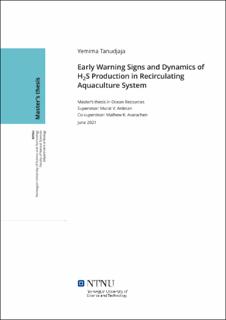| dc.description.abstract | The introduction of seawater, especially in post-smolt recirculating aquaculture system (RAS), has led to the formation of hydrogen sulfide (H2S) which is one of the major challenges in RAS that has caused sudden mass fish mortality in recent years. Some preventive measures have been taken to reduce the occurrence of H2S. However, a reliable system that can provide warning indicators indicating a situation leading to H2S is needed. Study of oxidation-reduction (redox) reactions becomes important in determining some possible warning indicators for H2S. According to the redox sequence, several electron acceptors can be used as warning signs, such as nitrate (NO3-), manganese (II) (Mn (II)), and iron (II) (Fe (II)) as their redox reactions precede the generation of H2S. This study focuses on the potential of Mn (II) and Fe (II) to be the warning indicators for H2S in RAS and the evaluation of their analysis methods. Furthermore, the development time of sulfidic condition in RAS as well as the total H2S production potential from RAS were also assessed to provide a complete picture of H2S generation in RAS.
In this study, the assessment of Mn (II) and Fe (II) as warning indicators for H2S along with the production of H2S from Atlantic salmon (Salmo salar L.) organic waste were conducted for 25 days under batch incubation consisting of two treatment conditions, with and without the addition of 6 mM of nitrate. Fe (II) analysis was performed in flow injection with luminol based chemiluminescence (FIA-CL) and inductively coupled plasma mass spectrometry (ICP-MS), whereas Mn (II) concentrations were measured in ICP-MS only. The concentrations of H2S were measured spectrophotometrically with methylene blue method. In addition, measurement of redox potential (Eh), pH, and dissolved O2 were also carried out.
The addition of nitrate could inhibit the production of H2S until day 15, while in the control (without nitrate addition), an increase in H2S level was observed since day 2. The total H2S production during 25 days of incubation ranged from 2.4–2.7 µM. In the nitrate treatment, the first increase in Mn (II) occurred from day 1, while the concentration of Fe (II) remained as low as the initial level until day 8 (measured with ICP-MS) and day 11 (measured with FIA-CL). In comparison to H2S, Mn (II) increased well before H2S formation, about 15 to 17 days earlier. On the other hand, Fe (II) was found to increase closer to H2S production than Mn (II), around 7 to 9 days earlier. In the control, Mn (II) and Fe (II) contents were seen to increase from day 1 and day 2, respectively, overlapping with H2S production.
The results demonstrates that both Mn (II) and Fe (II) can be used as warning indicators for H2S formation, however, Fe (II) is considered to be a better indicator than Mn (II) because it occurs not too long before H2S production. Despite measurement inaccuracies, FIA-CL is still reliable and considered more practical than ICP-MS to help system in RAS develop warning indicators for H2S formation as it allows on-site application and more real time analysis. | |
